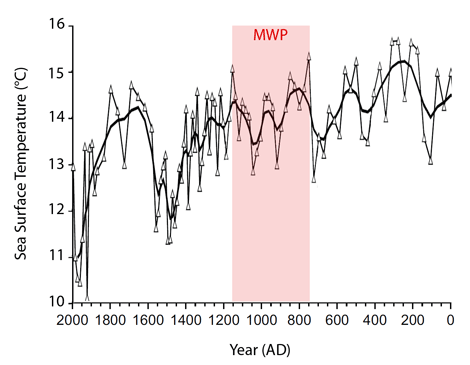Sediment cores from Lake Tutira, North Island, New Zealand (~39.23°S, 176.9°E) were analyzed to reconstruct a history of major storms for this region over the past 2,000 years. Results indicated six well-defined and "clearly distinguishable" storm periods of the pre-instrumental era, which are reproduced in the figure below. A seventh period based on data presented in Table 1 of the authors' paper has also been added to indicate comparable storms of the modern era.

A comparison of these data with several independent climate proxies throughout the region led the authors to conclude that stormy periods occurred during times when the climate was warmer overall. In this regard, they note that "the Mapara 2 period corresponds to sustained warm temperatures in the Tasmanian and Chilean tree-ring records which might indicate that the period represents a Southern Hemisphere-wide climate anomaly." Additionally, they report that "the Tufa Trig 1 period [AD 864-1014] corresponds to the early part of the Medieval Warm Period suggesting warmer temperatures occurred in New Zealand at this time." Similar correlations were noted among the other storm periods, leading us to infer that given the large number of storm events during the RWP and MWP, as compared to the CWP, it is likely the CWP has been neither as warm nor as protracted as either of these two earlier warm periods.
Another this week:
Feni Drift, Rockall Trough, Northeast Atlantic Ocean
Reference
Richter, T.O., Peeters, F.J.C. and van Weering, T.C.E. 2009. Late Holocene (0-2.4 ka BP) surface water temperature and salinity variability, Feni Drift, NE Atlantic Ocean. Quaternary Science Reviews 28: 1941-1955.Description
The authors obtained high-resolution (22-year average) planktonic foraminiferal Mg/Ca and stable oxygen isotope (δ18O) data from a pair of sediment cores retrieved from the northeast Atlantic Ocean's Feni Drift, Rockall Trough region (55°39.02'N, 13°59.10'W and 55°39.10'N, 13°59.13'W) from which they derived late-Holocene (0-2.4 ka BP) sea surface temperatures (SSTs). This work revealed the MWP to have occurred between approximately AD 750 and 1160; and a plot of the results (shown below) reveals the peak temperature of the MWP to have been about 2.3°C greater than the peak temperature of the late 20th century.

Sea surface temperature history of the northeast Atlantic's Feni Drift region, adapted from Richter et al. (2009).
No comments:
Post a Comment